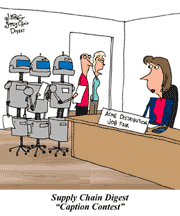Once Again, the Virus Drives All the Supply Chain News
I think the current virus situation is well captured in considering an address Gov. Mike DeWine gave Wednesday in my home state of Ohio.
For weeks, DeWine had given an update on the virus situation in the Buckeye state at 2 o'clock each afternoon. More recently, with the state opening up and some reasonably good news on infection and death toll counts, those daily briefings largely went away.
But now, the virus numbers are rapidly heading in the wrong direction, worse in some states, better in others. In Ohio, the numbers are good in some counties, going fast the other way in others.
| GILMORE SAYS: |
The virus has changed and will change our society in fundamental ways - and thus the supply chains that support how we live and work.
WHAT DO YOU SAY?
Send us your
Feedback here
|
No one knew what DeWine was going to say, now in an early evening address when the work day was done and the local TV channels would pick up the feed. Was the governor going to announce sweeping new restrictions and forced re-closings of various businesses? Or was he going to say "full speed ahead" for the opening path the state has been on?
Not only did we not know what direction DeWine would go, many of us, including me, were very unsure what we wanted DeWine's answer to be.
It turned out he mostly said to stay the course - but wear your face masks.
I went for more than two months writing about nothing in this column but the coronavirus and the supply chain starting in March, because as I repeatedly said then, who could really focus on anything else at the time?
But then the numbers turned better, the headlines started going away, and the grand opening ensued. I moved on to other topics. But now, the virus worry and headlines are back - and so is my focus on the subject again.
Let's start here. This week, the World Health Organization warned that there could be no return to normality any time soon, as too many countries were bungling their response to the coronavirus pandemic. WHO chief Tedros Adhanom Ghebreyesus said that if public health guidelines are not followed, the crisis will get "worse and worse and worse."
Whether the US bungled the response is a matter of debate. But regardless, CDC director Robert Redfield said this week that "I am worried. I do think the fall and the winter of 2020 and 2021 are probably going to be one of the most difficult times that we've experienced in American public health because of the co-occurrence of Covid and influenza." Yikes.
The warm summer weather has not as some predicted made the virus go away. Will cold fall and winter temperatures turn things worse than we saw this spring?
In more cheery news, Guy's and St. Thomas' National Health Service Foundation Trust in London released a study finding that people who have recovered from COVID-19 may lose their immunity to the virus within months, throwing the whole idea of "herd immunity" into question.
The study found that 60% of the patients had a "potent" antibody response at peak of their battle with the coronavirus. After about two months, however, just 16.7% of the patients had a potent antibody response, and it appeared totally gone in some.
Let's hope other scientists can't replicate the findings.
In the US, infections appear to have soared with the re-opening, at least in some states, though there was still some question about real levels versus just increased testing. That possibility was somewhat bolstered by the fact that the death tolls were flat or falling even with the rise in cases. Some suggested a rise in infections among younger people could explain that.
But now deaths do in fact appear to also be headed up.
"Cases began to rise on June 16; a week later, hospitalizations began to rise," The Atlantic magazine wrote this week, "Two weeks after that - 21 days after cases rose - states began to report more deaths. That's the exact number of days that the Centers for Disease Control and Prevention has estimated from the onset of symptoms to the reporting of a death."
So who knows where we go from here.
Turning back a little more specifically to the supply chain, an article this week in the Harvard Business Review web site commented on the changes coming to retail, noting that "The latest data from McKinsey shows that consumers are likely to keep the behaviors they've adopted amid stay-at-home orders, such as more online shopping and fewer mall visits."
I think we all know that.
More interestingly, the article says that "all retailers will have to make their in-store experiences even more extraordinary for those who can visit in person. They have to give people a reason to visit that is so compelling, it justifies their exposure to health risks and overcomes the inertia of the behaviors they adopted during the shutdown."
My question: is this really possible? I have my doubts.
We all know that coming out of this will be a big rise in use of robotics. With all their troubles with infections and plant closures, it should be no surprise that meat processors such as Tyson and others are reportedly accelerating plans to turn to robots.
Tyson, for example, is developing an automated deboning system to help butcher the nearly 40 million chickens it processes each week. Though it says humans are better at the job, the robots don't set sick.
The AP reported that robots that can cook - from flipping burgers to baking bread - are in growing demand as virus-wary kitchens try to put some distance between workers and customers.
 For example, beginning soon, the White Castle burger chain will test a robot arm that can cook french fries and other foods. There were restaurant chains testing burger flipping and pizza making robots before the pandemic, but surely the virus will now accelerate the trend - especially as patrons are looking for touch-free experiences. For example, beginning soon, the White Castle burger chain will test a robot arm that can cook french fries and other foods. There were restaurant chains testing burger flipping and pizza making robots before the pandemic, but surely the virus will now accelerate the trend - especially as patrons are looking for touch-free experiences.
And I hadn't heard this one: As salad bars shut down, Hayward, California-based Chowbotics built Sally, a robot about the size of a refrigerator that makes a variety of salads and bowls. Sally lets customers choose from 22 prepared ingredients stored inside the machine.
Most US restaurant are small businesses - and small businesses are struggling. As the AP also reported this week, "Small businesses around the world are fighting for survival amid the economic fallout from the coronavirus pandemic. Whether they make it will affect not just local economies but the fabric of communities."
As just one example, the AP story includes a report on a banquet hall in Washington state called The Vault. Earlier this year, it had booked 40 wedding receptions for the Spring and Summer season - all wiped out from virus closings.
The owner was approved for just $3,200 of the nearly $25,000 she sought from the federal Payroll Protection Program - before learning even that wouldn't be coming. The business is alive - but just barely - for now.
The virus has changed and will change our society in fundamental ways - and thus the supply chains that support how we live and work.
The federal government, by the way, spent $2.7 trillion dollars more than it took in during the first 9 months of the year just ended in June. Compare that to the worst annual deficit of all time, $1.2 trillion for all of 2009.
I think you can expect more stimulus spending soon. The results of those deficits is hard to say, but whatever they are, it won't be good.
And by the way, last week the US called China's activities in the South China Sea, far away from its coast line, "illegal" - setting the stage for even more naval showdowns - and perhaps worse. This will not end well.
I hope to get back away from the virus soon - because things once again start to get better.
Any reaction to Gilmore's thoughts this week? Does the virus once again dominate all othr news? Let us know your thought at the Feedback section below.
|










 For example, beginning soon, the White Castle burger chain will test a robot arm that can cook french fries and other foods. There were restaurant chains testing burger flipping and pizza making robots before the pandemic, but surely the virus will now accelerate the trend - especially as patrons are looking for touch-free experiences.
For example, beginning soon, the White Castle burger chain will test a robot arm that can cook french fries and other foods. There were restaurant chains testing burger flipping and pizza making robots before the pandemic, but surely the virus will now accelerate the trend - especially as patrons are looking for touch-free experiences.


